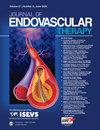Radiomics-Based Risk Assessment Correlates With Outcomes in Patients With Acute Type B Aortic Dissection Undergoing Thoracic Endovascular Repair
IF 1.7
2区 医学
Q3 PERIPHERAL VASCULAR DISEASE
引用次数: 0
Abstract
Objectives:Our study aimed to investigate the correlations between radiomics-based assessment and outcomes, including positive aortic remodeling (PAR), reintervention for dissection at 1 year, and overall survival, in patients with Type B aortic dissection (TBAD) who underwent thoracic endovascular aortic repair (TEVAR).Methods:This was a single-center, retrospective, cohort study. The cohort comprised 104 patients who had undergone TEVAR of TBAD in our institution between January 2010 and October 2022. We segmented preoperative computed tomography (CT) images of the patients’ descending aorta regions, then extracted a comprehensive set of radiomic features, including first-order features, shape features (2D and 3D), gray-level co-occurrence matrix (GLCM), gray-level size zone matrix, gray-level run length matrix, gray-level dependence matrix, neighborhood gray-tone difference matrix, from the regions of interest. Next, we selected radiomics features associated with total descending aorta positive aortic remodeling (TDA-PAR) and reintervention by least absolute shrinkage and selection operator (LASSO) regression and features associated with survival by LASSO-Cox regression. This enabled us to calculate radiomics-based risk scores for each patient. We then allocated the patients to high and low radiomics-based risk groups, the cutoff being the median score. We used 3 different models to validate the radiomics-based risk scores.Results:The patients’ baseline characteristics did not differ between those who achieved TDA-PAR and those who did not. The radiomics-based risk scores were significantly and independently associated with all 3 outcomes. As to the impact of specific radiomics features, we found that GLSZM_SmallAreaLowGrayLevelEmphasis and shape_Maximum2DDiameterColumn had positive impacts on both reintervention and survival outcomes, whereas GLCM_Idmn positively affected survival but negatively affected reintervention. We found that radiomics-based risk for TDA-PAR correlated most significantly with zone 6 PAR.Conclusions:Radiomics-based risk scores were significantly associated with the outcomes of TDA-PAR, reintervention, and overall survival. Radiomics has the potential to make significant contributions to prediction of outcomes in patients with TBAD undergoing TEVAR.Clinical ImpactIn this study of 104 patients with Type B aortic dissection, we demonstrated associations between radiomics-based risk and postoperative outcomes, including total descending aorta positive aortic remodeling, reintervention and survival. These findings highlight radiomics’ potential as a tool for risk stratification and prognostication in acute Type B aortic dissection management.基于放射组学的风险评估与接受胸腔内血管修复术的急性 B 型主动脉夹层患者的预后有关
目的:我们的研究旨在调查接受胸腔内血管主动脉修复术(TEVAR)的B型主动脉夹层(TBAD)患者基于放射组学的评估与结果之间的相关性,包括主动脉重塑(PAR)阳性、1年后因夹层再次介入以及总生存期。该队列包括2010年1月至2022年10月期间在我院接受TEVAR治疗的104例TBAD患者。我们对患者降主动脉区域的术前计算机断层扫描(CT)图像进行了分割,然后从感兴趣区域提取了一整套放射组学特征,包括一阶特征、形状特征(二维和三维)、灰度级共现矩阵(GLCM)、灰度级大小区矩阵、灰度级运行长度矩阵、灰度级依赖性矩阵、邻域灰调差异矩阵。接下来,我们通过最小绝对收缩和选择算子(LASSO)回归法选出了与全降主动脉正性重塑(TDA-PAR)和再介入相关的放射组学特征,并通过 LASSO-Cox 回归法选出了与生存相关的特征。这样,我们就能为每位患者计算出基于放射组学的风险评分。然后,我们将患者分配到基于放射组学的高风险组和低风险组,分数中位数为分界线。结果:达到 TDA-PAR 和未达到 TDA-PAR 的患者的基线特征没有差异。基于放射组学的风险评分与所有 3 种结果都有显著的独立相关性。至于特定放射组学特征的影响,我们发现 GLSZM_SmallAreaLowGrayLevelEmphasis 和 shape_Maximum2DDiameterColumn 对再干预和生存结果都有积极影响,而 GLCM_Idmn 对生存有积极影响,但对再干预有消极影响。我们发现,基于放射组学的 TDA-PAR 风险与 6 区 PAR 的相关性最为显著。临床影响在这项针对 104 名 B 型主动脉夹层患者的研究中,我们证实了基于放射组学的风险与术后结果(包括总降主动脉正性主动脉重塑、再介入和存活率)之间的关联。这些发现凸显了放射组学作为急性 B 型主动脉夹层管理中风险分层和预后判断工具的潜力。
本文章由计算机程序翻译,如有差异,请以英文原文为准。
求助全文
约1分钟内获得全文
求助全文
来源期刊
CiteScore
5.30
自引率
15.40%
发文量
203
审稿时长
6-12 weeks
期刊介绍:
The Journal of Endovascular Therapy (formerly the Journal of Endovascular Surgery) was established in 1994 as a forum for all physicians, scientists, and allied healthcare professionals who are engaged or interested in peripheral endovascular techniques and technology. An official publication of the International Society of Endovascular Specialists (ISEVS), the Journal of Endovascular Therapy publishes peer-reviewed articles of interest to clinicians and researchers in the field of peripheral endovascular interventions.

 求助内容:
求助内容: 应助结果提醒方式:
应助结果提醒方式:


